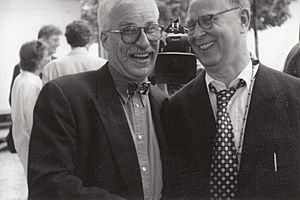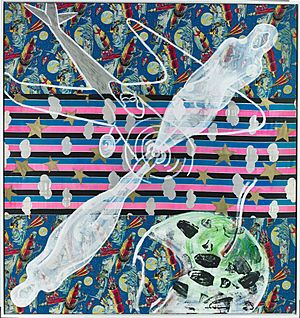Sigmar Polke facts for kids
Quick facts for kids
Sigmar Polke
|
|
|---|---|

Sigmar Polke (right) with his friend Dieter Frowein-Lyasso
|
|
| Born | 13 February 1941 |
| Died | 10 June 2010 (aged 69) Cologne, Germany
|
| Education | Kunstakademie Düsseldorf |
| Known for | Painting, Photography |
| Movement | Capitalist realism |
| Awards | Rubens Prize of the City of Siegen (2007) |
Sigmar Polke (born February 13, 1941 – died June 10, 2010) was a famous German artist. He was known for his paintings and photographs.
Polke loved to try new things in his art. He used many different styles, topics, and materials. In the 1970s, he focused on photography. Then, in the 1980s, he started painting again. His later abstract works often showed what happened when paint mixed with other chemicals. Towards the end of his life, he painted about historical events and how people saw them.
Contents
Sigmar Polke's Early Life and Education
Polke was born in a town called Oels, which is now in Poland. He was the seventh of eight children in his family. In 1945, his family had to leave their home during the end of World War II. They moved to Thuringia.
In 1953, his family escaped from the Communist government in East Germany. They first went to West Berlin and then to West Germany. When Polke arrived in West Germany, he started visiting art galleries and museums. He worked as an apprentice in a factory that made stained glass in Düsseldorf from 1959 to 1960.
At age twenty, he began studying at the Kunstakademie Düsseldorf (Arts Academy). He learned from great teachers like Joseph Beuys. This was a time of big changes in art and society in Germany. Düsseldorf was a busy city and a center for art. In the early 1970s, Polke lived in an artists' community called Gaspelhof.
From 1977 to 1991, Polke taught art at the Academy of Fine Arts in Hamburg. He moved to Cologne in 1978. He lived and worked there until he passed away in June 2010 after a long illness.
What Kind of Art Did Sigmar Polke Make?
In 1963, Polke started an art movement called "Kapitalistischer Realismus" (Capitalist Realism). He created it with other artists like Gerhard Richter. This art style used images from advertising. It was a bit like "Socialist Realism", which was the official art style in the Soviet Union. But Polke's art also made comments about how Western countries focused on buying things.
Polke also took part in an art show in a store in Düsseldorf. He taught himself photography. For the next few years, he painted, made films, and did performance art.
Polke's Photography and Experiments
From 1966 to 1968, Polke used a camera to take pictures of everyday objects in his home. In 1968, he published these photos in a collection. They showed small sculptures he made from things like buttons and balloons. Between 1968 and 1971, he made several films and took thousands of photos.
In the 1970s, Polke traveled a lot to places like Afghanistan, Brazil, and the U.S. He took many photos and videos during these trips. He later used these in his art in the 1980s. He often changed his photos in the darkroom. He would combine different negatives and positives. He also used techniques like making images too dark or too light. This created mysterious and dream-like pictures.
In 1995, Polke worked with his wife, Augustina von Nagel, on a series of 35 prints. These combined street photos with images from his paintings. He used special techniques to layer the images.
Polke's Painting Styles
Polke's early paintings are sometimes called European Pop art. This is because he painted everyday things like sausages and potatoes. He also used images from newspapers and magazines. He often copied the dot patterns used in printing. He would carefully paint each dot himself. This made people think about how true or real media images were.
Sometimes, Polke painted on fabric that was meant for furniture. This made the fabric part of the art. His drawings and watercolors from the 1960s and 1970s show his imagination and humor. They often made fun of consumer society and politics in Germany after the war.

When Polke returned to painting in the 1980s, he became interested in how chemicals react. He traveled to Australia and Southeast Asia. He started using unusual materials like arsenic, meteor dust, and even snail slime in his paints. He made large, bold paintings that mixed real-looking images with abstract shapes.
He experimented with mixing traditional paints with solvents and resins. These mixtures created unexpected chemical reactions on the canvas. These paintings made people think about what makes art original. Polke often made his painting fabric see-through by soaking it in resin. He would also paint shapes on the back of the canvas, so they looked like shadows. He sometimes poured colors onto the canvas and let them spread on their own.
In 1994, he made a painting called The Three Lies of Painting. It showed a landscape mixed with abstract shapes and a strip of printed fabric. This fabric had many colorful hands on it, suggesting the artist's own role in creating the art. In the mid-1990s, Polke started a series called "Druckfehler" (Printing Mistakes). He was inspired by errors he found in newspaper printing. He would enlarge these mistakes and paint them onto polyester. He even made some of these "mistakes" himself, like stretching figures with a photocopier.
In 2002, Polke started using a new technique called "machine painting." These were his first paintings made completely by machines. He would change images on a computer and then print them onto large pieces of fabric. Before this, he preferred to create mechanical effects by hand.
From 2007, Polke worked on his "Lens Paintings." These paintings were based on old ideas about how lenses work. Polke's painted "lenses" create different shapes and illusions when you look at them from different angles.
Polke's Films and Commissioned Art
Polke also made films. In 1969, he made a film called Der ganze Körper fühlt sich leicht und möchte fliegen (The Whole Body Feels Light and Wants to Fly). In this film, he scratched himself and used a pendulum.
Polke also created art for special places. For the reopening of the Reichstag in Berlin in 1999, he made large, three-dimensional lightboxes. The images on these lightboxes changed as people walked past them. He also designed beautiful stained glass windows for the Grossmünster cathedral in Zurich between 2006 and 2009. This used his early training in glass painting.
Where Was Sigmar Polke's Art Shown?
Polke had his first solo art show in West Berlin in 1966. His first solo show in New York was in 1982. His art was shown in many important exhibitions around the world. These included shows at the Tate Modern in London (2003–2004) and the Getty Center in Los Angeles (2007).
In 2007, a large exhibition of his work called "Sigmar Polke: Retrospektive" was held. Also in 2007, his huge painting series Axial Age was shown for the first time at the Venice Biennale. Polke wanted this work to stay on display in Venice. A big show of his art, "Alibis: Sigmar Polke 1963–2010," was planned for The Museum of Modern Art in New York in 2014. It also traveled to London and Cologne.
Sigmar Polke's Influence on Other Artists
Polke's art had a big impact on many artists around the world. Younger artists like Martin Kippenberger and Richard Prince were influenced by him. The artist John Baldessari called Polke an "artist's artist." Today, Polke is often mentioned with Gerhard Richter. Both artists grew up and experimented with art in West Germany in the 1960s.
How Much is Sigmar Polke's Art Worth?
Polke's paintings and drawings of everyday items became popular early on. His works from the mid-1960s are still very well-known and have sold for high prices at auctions. In 2007, a painting from 1966 called Strand (Beach) sold for about $5.3 million.
In 2011, Polke's City Painting II (1968) sold for $7.4 million. His painting Jungle (1967) set a new record for his art at $9.2 million. In 2015, Jungle sold again for an even higher price of $27.1 million.
Polke's family has created the Estate of Sigmar Polke. This group manages his art and keeps an archive in his old studio. They are also working on a complete list of all his paintings, photos, and works on paper.
Awards and Recognition
- 1964: Won the Young Germans award in Baden-Baden.
- 1975: Won the prize for painting at the XIII Bienal de São Paulo.
- 1986: Won a "Golden Lion" at the XLII Biennale di Venezia.
- 1988: Won the 1988 Baden-Württemberg International Prize for Painting.
- 1994: Won the "Erasmus Prize" in Amsterdam.
- 1995: Won the Carnegie Prize in Pittsburgh, Pennsylvania.
- 1998: Won the International Center of Photography, Infinity Award for Art.
- 1999: Won the Wolf Prize (but he chose not to accept it).
- 2000: Won the "Goslarer Kaiserring" in Goslar, Germany.
- 2002: Won the "Praemium Imperiale" from the Japan Art Association.
- 2007: Won the "Rubens Prize" in Siegen, Germany.
- 2008: Became a Foreign Honorary Member in the American Academy of Arts and Sciences.
- 2009: Became an Honorary Member in the American Academy of Arts and Letters.
- 2010: Won the "Roswitha Haftmann Prize" in Zurich.
See also
 In Spanish: Sigmar Polke para niños
In Spanish: Sigmar Polke para niños
- The Portrait Now


